While many consumers across the country are still dealing with significant amounts of credit card debt and other financial issues, new data suggest that it’s women who are facing larger burdens as a result of more borrowing missteps.
Though more than 75 percent of all Americans have at least one credit card, and the average person has 3.7 with about $5,600 in outstanding balances, women are more likely than men to mishandle their accounts and run into larger debts as a consequence, according to new data from FINRA. For instance, 60 percent of women surveyed said they regularly carried a balance from one month to the next, compared to just 55 percent of men. Further, 42 percent of women said they only paid the minimum required by their lender every month, and 38 percent of men responded similarly.
Women also tended to suffer more when it came to facing fees for their credit card mistakes, the report said. In all, 29 percent said they had faced penalty charges for late payments, and 16 were hit with fees for exceeding their borrowing limit. That’s compared to 23 and 15 percent of men, respectively, who responded the same way. However, women were slightly less likely to use their credit cards to take a cash advance, with 12 percent saying they did so, compared to 15 percent of men. Women were also more likely to exhibit at least two of these problematic behaviors with 38 percent doing so, compared to just 33 percent of men.
At the same time, men also showed a greater amount of positive behavior, the report said. Some 45 percent paid their balance off in full every month, while 39 percent of women did so, and 37 percent comparison shopped for credit cards compared with only 31 percent of women. And perhaps as a result of the latter statistic, women also tend to have higher interest rates on their credit cards than men regardless of their financial wherewithal. Those with low financial literacy paid an average of 15 percent on their balance, compared with 14.5 percent for men with similar knowhow. Women with high financial literacy carried APRs averaging 14.7 percent, slightly higher than 14.1 percent for similarly-educated men.
All consumers should always take the time to weigh a number of credit card options to determine the one that’s best for them and their unique financial situations.
[Credit Cards: Research and compare credit cards at Credit.com]
---
Credit.com provides readers with unique insight, helpful tips and straight answers about their financial world. Our team of reporters and experts explore credit, loans, debt, saving, and identity theft topics, all designed to help you make smarter financial decisions. Visit Credit.com to sign up for your FREE Credit Report Card and find out where you stand today!












